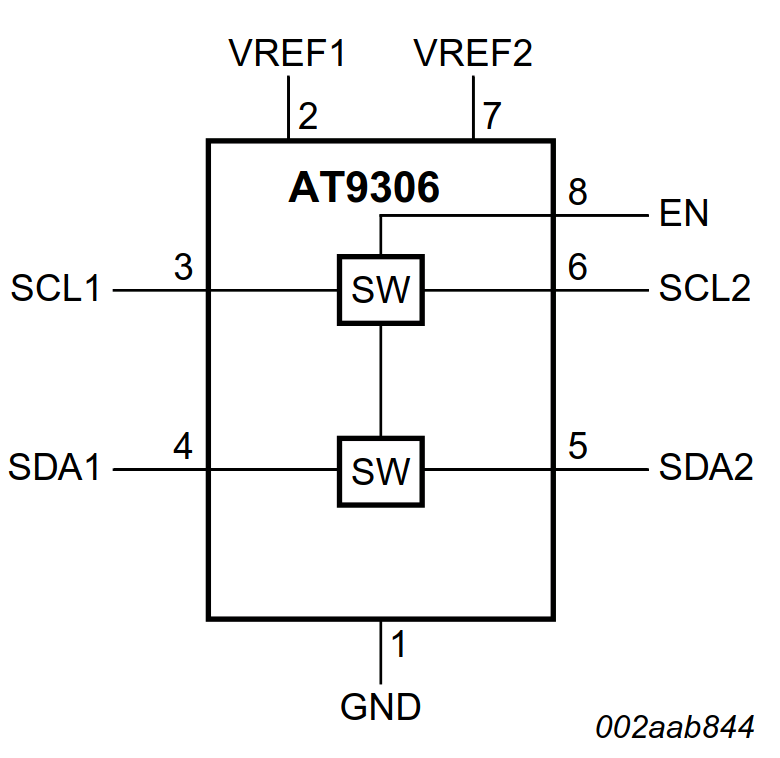|
AT9306
description The AT9306 is a dual bidirectional I2C-bus and SMBus voltage -level translator with an enable (EN) input, and is operational from 1.0 V to 3.6 V (Vref(1)) and 1.8 V to 5.5 V(Vbias(ref)(2)). The AT9306 allows bidirectional voltage translations between 1.0V and 5V without the use of a direction pin. The low ON-state resistance (R on) of the switch allows connections to be made with minimal propagation delay. When EN is HIGH, the translator switch is on, and the SCL1 and SDA1 I/O are connected to the SCL2 and SDA2 I/O, respectively, allowing bidirectional data flow between ports. When EN is LOW, the translator switch is off, and a high-impedance state exists between ports. The AT9306 is not a bus buffer like the AT9509 or AT9517A that provide both level translation and physically isolates the capacitance to either side of the bus when both sides are connected. The AT9306 only isolates both sides when the device is disabled and provides voltage level translation when active. The AT9306 can also be used to run two buses, one at 400 kHz operating frequency and the other at 100 kHz operating frequency. If the two buses are operating at different frequencies, the 100 kHz bus must be isolated when the 400 kHz operation of the other bus is required. If the master is running at 400 kHz, the maximum system operating frequency may be less than 400 kHz because of the delays added by the translator. As with the standard I2C-bus system, pull-up resistors are required to provide the logic HIGH levels on the translator’s bus. The AT9306 has a standard open-collector configuration of the I2C-bus. The size of these pull-up resistors depends on the system, but each side of the translator must have a pull-up resistor. The device is designed to work with Standard-mode, Fast-mode and Fast -mode Plus I2C-bus devices in addition to SMBus devices. The maximum frequency is dependent on the RC time constant, but generally supports > 2 MHz. When the SDA1 or SDA2 port is LOW, the clamp is in the ON-state and a low resistance connection exists between the SDA1 and SDA2 ports. Assuming the higher voltage is on the SDA2 port when the SDA2 port is HIGH, the voltage on the SDA1 port is limited to the voltage set by VREF1. When the SDA1 port is HIGH, the SDA2 port is pulled to the drain pull-up supply voltage (VPU(1)) by the pull-up resistors. This functionality allows a seamless translation between higher and lower voltages selected by the user without the need for directional control. The SCL1/SCL2 channel also functions as the SDA1/SDA2 channel. features and benefits 2-bit bidirectional translator for SDA and SCL lines in mixed-mode I2C-bus applications Standard-mode, Fast-mode, and Fast-mode Plus I2C-bus and SMBus compatible Less than 1.5 ns maximum propagation delay to accommodate Standard-mode and Fast-mode I2C-bus devices and multiple masters Provides bidirectional voltage translation with no direction pin Low 3.5W ON-state connection between input and output ports provides less signal distortion Open-drain I2C-bus I/O ports (SCL1, SDA1, SCL2 and SDA2) 5V tolerant I2C-bus I/O ports to support mixed-mode signal operation High-impedance SCL1, SDA1, SCL2 and SDA2 pins for EN = LOW Lock-up free operation Flow through pinout for ease of printed-circuit board trace routing ESD protection exceeds 2000 V HBM per JESD22-A114 and 1000 V CDM per JESD22-C101 Packages offered: SO8, TSSOP8, VSSOP8, XQFN8, XSON8, XSON8U diagram
|






